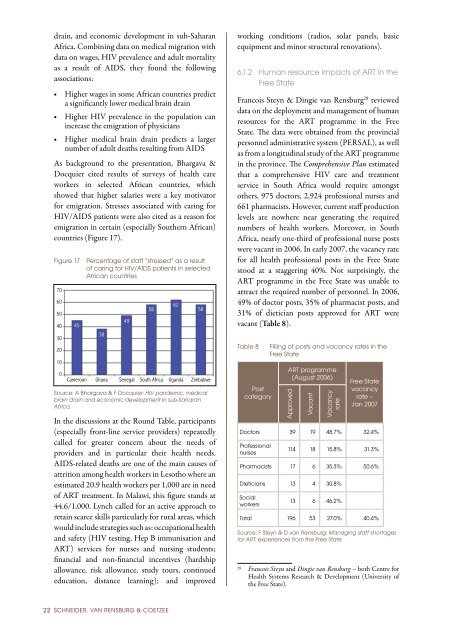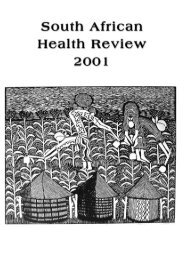Round Table Report - UCT Main - University of Cape Town
Round Table Report - UCT Main - University of Cape Town
Round Table Report - UCT Main - University of Cape Town
You also want an ePaper? Increase the reach of your titles
YUMPU automatically turns print PDFs into web optimized ePapers that Google loves.
drain, and economic development in sub-Saharan<br />
Africa. Combining data on medical migration with<br />
data on wages, HIV prevalence and adult mortality<br />
as a result <strong>of</strong> AIDS, they found the following<br />
associations:<br />
■■<br />
■■<br />
■■<br />
Higher wages in some African countries predict<br />
a significantly lower medical brain drain<br />
Higher HIV prevalence in the population can<br />
increase the emigration <strong>of</strong> physicians<br />
Higher medical brain drain predicts a larger<br />
number <strong>of</strong> adult deaths resulting from AIDS<br />
As background to the presentation, Bhargava &<br />
Docquier cited results <strong>of</strong> surveys <strong>of</strong> health care<br />
workers in selected African countries, which<br />
showed that higher salaries were a key motivator<br />
for emigration. Stresses associated with caring for<br />
HIV/AIDS patients were also cited as a reason for<br />
emigration in certain (especially Southern African)<br />
countries (Figure 17).<br />
Figure 17 Percentage <strong>of</strong> staff “stressed” as a result<br />
<strong>of</strong> caring for HIV/AIDS patients in selected<br />
African countries<br />
70<br />
60<br />
50<br />
40<br />
30<br />
20<br />
10<br />
45<br />
38<br />
49<br />
0<br />
Cameroon Ghana Senegal South Africa Uganda Zimbabwe<br />
Source: A Bhargava & F Docquier: HIV pandemic, medical<br />
brain drain and economic development in sub-Saharan<br />
Africa.<br />
In the discussions at the <strong>Round</strong> <strong>Table</strong>, participants<br />
(especially front-line service providers) repeatedly<br />
called for greater concern about the needs <strong>of</strong><br />
providers and in particular their health needs.<br />
AIDS-related deaths are one <strong>of</strong> the main causes <strong>of</strong><br />
attrition among health workers in Lesotho where an<br />
estimated 20.9 health workers per 1,000 are in need<br />
<strong>of</strong> ART treatment. In Malawi, this figure stands at<br />
44.6/1,000. Lynch called for an active approach to<br />
retain scarce skills particularly for rural areas, which<br />
would include strategies such as: occupational health<br />
and safety (HIV testing, Hep B immunisation and<br />
ART) services for nurses and nursing students;<br />
financial and non-financial incentives (hardship<br />
allowance, risk allowance, study tours, continued<br />
education, distance learning); and improved<br />
58<br />
62<br />
58<br />
working conditions (radios, solar panels, basic<br />
equipment and minor structural renovations).<br />
6.1.2 Human resource impacts <strong>of</strong> ART in the<br />
Free State<br />
Francois Steyn & Dingie van Rensburg 28 reviewed<br />
data on the deployment and management <strong>of</strong> human<br />
resources for the ART programme in the Free<br />
State. The data were obtained from the provincial<br />
personnel administrative system (PERSAL), as well<br />
as from a longitudinal study <strong>of</strong> the ART programme<br />
in the province. The Comprehensive Plan estimated<br />
that a comprehensive HIV care and treatment<br />
service in South Africa would require amongst<br />
others, 975 doctors, 2,924 pr<strong>of</strong>essional nurses and<br />
661 pharmacists. However, current staff production<br />
levels are nowhere near generating the required<br />
numbers <strong>of</strong> health workers. Moreover, in South<br />
Africa, nearly one-third <strong>of</strong> pr<strong>of</strong>essional nurse posts<br />
were vacant in 2006. In early 2007, the vacancy rate<br />
for all health pr<strong>of</strong>essional posts in the Free State<br />
stood at a staggering 40%. Not surprisingly, the<br />
ART programme in the Free State was unable to<br />
attract the required number <strong>of</strong> personnel. In 2006,<br />
49% <strong>of</strong> doctor posts, 35% <strong>of</strong> pharmacist posts, and<br />
31% <strong>of</strong> dietician posts approved for ART were<br />
vacant (<strong>Table</strong> 8).<br />
<strong>Table</strong> 8<br />
Post<br />
category<br />
Filling <strong>of</strong> posts and vacancy rates in the<br />
Free State<br />
ART programme<br />
(August 2006)<br />
Approved<br />
Vacant<br />
Vacancy<br />
rate<br />
Free State<br />
vacancy<br />
rate –<br />
Jan 2007<br />
Doctors 39 19 48.7% 32.4%<br />
Pr<strong>of</strong>essional<br />
nurses<br />
114 18 15.8% 31.3%<br />
Pharmacists 17 6 35.3% 50.6%<br />
Dieticians 13 4 30.8%<br />
Social<br />
workers<br />
13 6 46.2%<br />
Total 196 53 27.0% 40.4%<br />
Source: F Steyn & D van Rensburg: Managing staff shortages<br />
for ART: experiences from the Free State.<br />
28 Francois Steyn and Dingie van Rensburg – both Centre for<br />
Health Systems Research & Development (<strong>University</strong> <strong>of</strong><br />
the Free State).<br />
22 Schneider, Van Rensburg & Coetzee

















